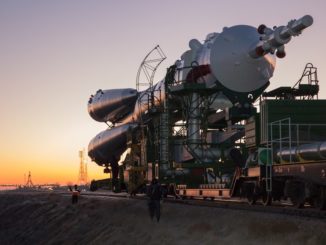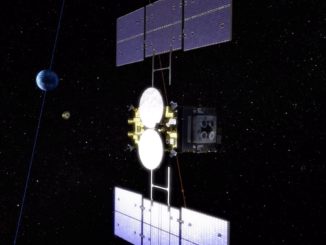
The first picture of NASA’s Perseverance rover landing on Mars shows the nuclear-powered robot suspended under its rocket jetpack just before touchdown. The spectacular view could be upstaged next week with the release of a first-of-its-kind high-definition video replay of the rover’s final descent.
The spacecraft carried six “ruggedized” commercial off-the-shelf cameras to capture video during descent toward Jezero Crater, home to an ancient lakebed that scientists hope harbors clues about the possibility that Mars had life billions of years ago.
Three of the cameras were located on top of the craft’s backshell to record video of the supersonic parachute, which helped slow down the rover after entering the Martian atmosphere. After releasing the backshell, the mission’s descent stage fired eight throttleable braking rockets before lowering the one-ton rover to the surface of Mars in a maneuver known as the “sky crane.”
There were two cameras on the rover itself, one looking down and another looking up at the rocket pack. And another camera on the descent stage captured imagery of the rover suspended under nylon cords during touchdown Thursday.
NASA released a still image from that camera Friday, offering a never-before-seen view of a spacecraft landing on another planet.
“When I think on our human space exploration, I am brought to remember the images that bring us humans into that process,” said Adam Steltzner, the Mars 2020 mission’s chief engineer at NASA’s Jet Propulsion Laboratory in California.
Steltzner, a veteran JPL engineer, compared the bird’s-eye view of the Perseverance rover to other iconic photos in space exploration, such as astronauts on the moon, the first up-close view of Saturn and its rings, and famous images from the Hubble Space Telescope.
“We can only hope in our efforts to engineer spacecraft and explore our solar system that we might be able to someday contribute yet another iconic image to this collection,” Steltzner said. “I’m happy to say that I’m hopeful we can with this.”
The picture shows Perseverance around 7 feet, or 2 meters, above the surface of Mars, Steltzner said.
“You can see the mechanical bridles that hold the rover underneath the descent stage, (the) three straight lines heading down to the top deck,” Steltzner said. “And then the curly electrical umbilical that is taking all of the electrical signals from the descent stage down to the computer inside the belly of the rover.”
The nylon bridles unspooled to a length of about 25 feet, or 7.6 meters, as the descent stage’s retrorockets slowed the vehicle to gently place the rover on the surface. Once the rover detected touchdown, pyrotechnically fired blades engaged to sever the connection with the descent stage, which flew a safe distance away before intentionally crashing into the planet.
Steltzner said the picture released Friday helps bring people on the adventure of space exploration.
“The plumes (from the rocket exhaust) are hitting the surface of Mars, kicking up little wisps of dust,” he said. “It is absolutely exhilarating, and it is evocative of those other images from our experience as human beings moving out into our solar system, those images that bring us into our process of exploration, and I’m so happy that we can contribute another to that collection.”

Since landing Thursday, the Perseverance rover has fired pyrotechnic restraints to release camera lens covers, the craft’s high-gain communications antenna, and robotic arm, according to Pauline Hwang, the rover’s assistant strategic mission manager.
More checkouts of the rover and its instruments are planned this weekend, including deployment of Perseverance’s remote sensing mast, which has a panoramic camera and a Mars weather station. That will allow the rover to begin taking images for a 360-degree panorama in the next few days.
Additional communications sessions with the rover this weekend will be used to transmit more imagery from Thursday’s landing. Mission managers said they hope to have video from the landing available in time to release it during a press conference Monday.
“We’re all chomping at the bit,” said Aaron Stehura, deputy lead for the rover’s entry, descent, and landing phase. “Seeing the rover hanging underneath the sky crane, underneath our rocket-powered jet pack, this is something that we’ve never seen before. It was stunning, and the team was awestruck, and there was just a feeling of victory that we were able to capture this and share it with the world.”
A microphone on the port side of the rover was expected to record audio during Perseverance’s landing Thursday. Steltzner said the ground team hopes to confirm this weekend if the microphone worked, and if so, the recording could be downlinked later this weekend or next week. If it worked, the recording may contain audio of the sounds of pyrotechnic devices firing to release the parachute and the sound of the descent stage engines, according to NASA.
NASA’s Mars Reconnaissance Orbiter snapped a picture of Perseverance as it flew under parachute toward the landing zone in Jezero Crater. MRO’s sharp-eyed mapping camera, known as HiRISE, spotted the rover from a distance of 435 miles, or 700 kilometers, NASA said.

Perseverance also downlinked more pictures from its hazard avoidance cameras overnight, revealing Jezero Crater in color for the first time. An escarpment is visible on the horizon, along with scattered rocks and boulders in the distance.
But the rover ended up at a location with a tilt of just 1 degree, with no obstacles that prevented a safe landing. Perseverance was the first Mars lander to use terrain relative navigation, algorithms that used images taken during descent and compared them pre-loaded orbital imagery, allowing the rover to steer to a safe location within the mission’s broader landing zone.
Steltzner said Perseverance’s landing “went as smoothly as we could have wanted it to go.” The navigation algorithms took the rover “to an almost pool table flat landing site with rocks small compared the size of the rover’s wheels.”
That is “exactly what we were hoping for,” Steltzner said Friday. “So the day went very, very well. We will, as we always do, comb … through the detail and look for anomalies that might teach us how to do our jobs better in the future, nut we didn’t see any huge ones that stuck out yesterday.”
With more pictures coming down from the rover every day, Stehura said it’s possible Perseverance may have taken photos of the descent stage rocket pack impacting the ground somewhere near the landing site.
Beginning as soon as Monday, ground teams at JPL will send up commands for Perseverance start transitioning to new software governing the rover’s mission on the surface of Mars. Up to now, the rover has operated on software designed for the cruise from Earth to Mars, and the entry, descent, and landing, Hwang said.
The process will take about four sols — a sol is a Martian day, lasting nearly 24 hours, 40 minutes — and will occur “very slowly and deliberately,” Hwang said. “We have two computers on the rover, our prime and our backup computer, so we actually do a checkout of the flight computers before we do full upgrade.”
The software code is already stored on the rover’s computers. The transition involves telling the computers — first the prime and then the backup — to “toe dip” into the new software then to switch back to the existing code. Engineers on Earth will evaluate how the computers performed during the changeover, then give the final “go” to fully transition to the surface operations software.

With the new software, Perseverance will be ready to perform checkouts of its robotic arm. The first test drive is expected around Perseverance’s ninth full day on Mars, or around Feb. 27.
If all goes as planned, the rover will complete its post-landing tests and activations next month, clearing the way for Perseverance to drive to a nearby location to deploy the Ingenuity helicopter, a 4-pound (1.8-kilogram) rotorcraft that will attempt to become the first such device to fly through the atmosphere of another planet.
Hwang said the first flight of the helicopter might occur around 60 sols after landing, or some time in mid-to-late April. The test flight might happen earlier if the checkouts with the rover go quicker than expected.
The first pictures from the surface of Jezero Crater also have scientists eager to begin their exploration of a new site on the Red Planet. The 28-mile-wide (45-kilometer) crater was created about 3.8-to-3.9 billion years ago by the impact of an asteroid or comet.
The crater was home to a body of liquid water more than 3 billion years ago, with evidence that river once flowed into the lake, depositing sediments in a delta. The rocks Perseverance will study inside the crater are likely between 3.6-to-3.8 billion years old, said Katie Stack Morgan, the mission’s deputy project scientist.
“This is a time in Mars history when water was stable on the surface of Mars, and we think this area would have been a habitable environment,” Morgan said.
One rock visible next to one of Perseverance’s six wheels has already caught the attention of scientists. The rock has holes, which might have been left behind as it solidified from lava, assuming the rock had a volcanic origin. If the rock was created by sedimentary deposits in the ancient lake at Jezero Crater, the holes might have carved from water that flowed through the material, according to Morgan.
“We have to get our instruments out and look at these textures in fine detail and help us make that determination,” Morgan said.
Scientists want Perseverance to gather both volcanic and sedimentary rock samples for return to Earth by a future mission. Once the specimens are back on Earth, perhaps as soon as 2031, scientists will be able to precisely date the volcanic rocks to anchor assumptions about the evolution of Mars, Morgan said. Sedimentary rocks returned to Earth will tell scientists about the environment of the lake that once filled Jezero Crater, and might contain evidence that the Red Planet had life.

After releasing the Ingenuity helicopter for its test flight campaign, Perseverance will begin visiting scientific targets and could collect its first rock sample this summer. The rover will likely head toward the dried-up river delta, which Morgan said is located a little more than a mile (2 kilometers) from Perseverance’s landing site.
“We can’t wait to get this science mission started,” Morgan said.
Email the author.
Follow Stephen Clark on Twitter: @StephenClark1.



